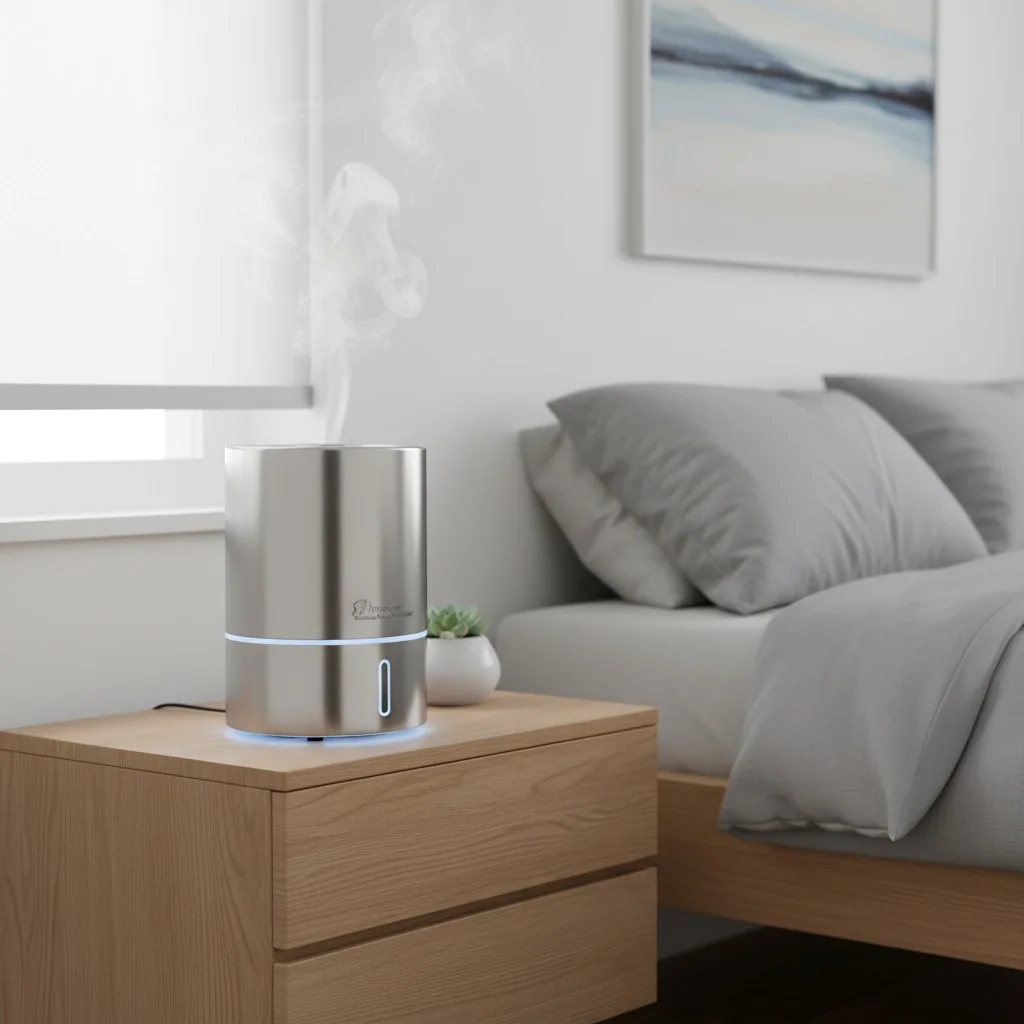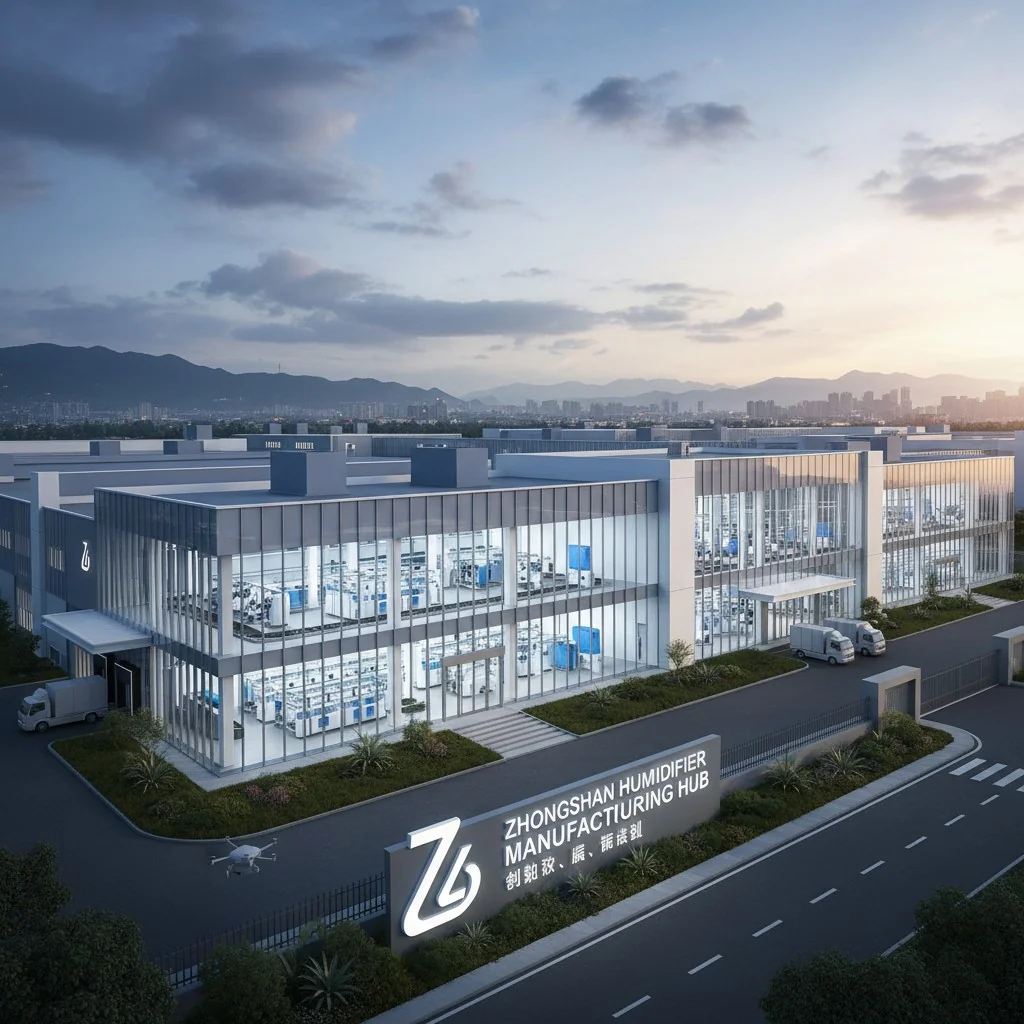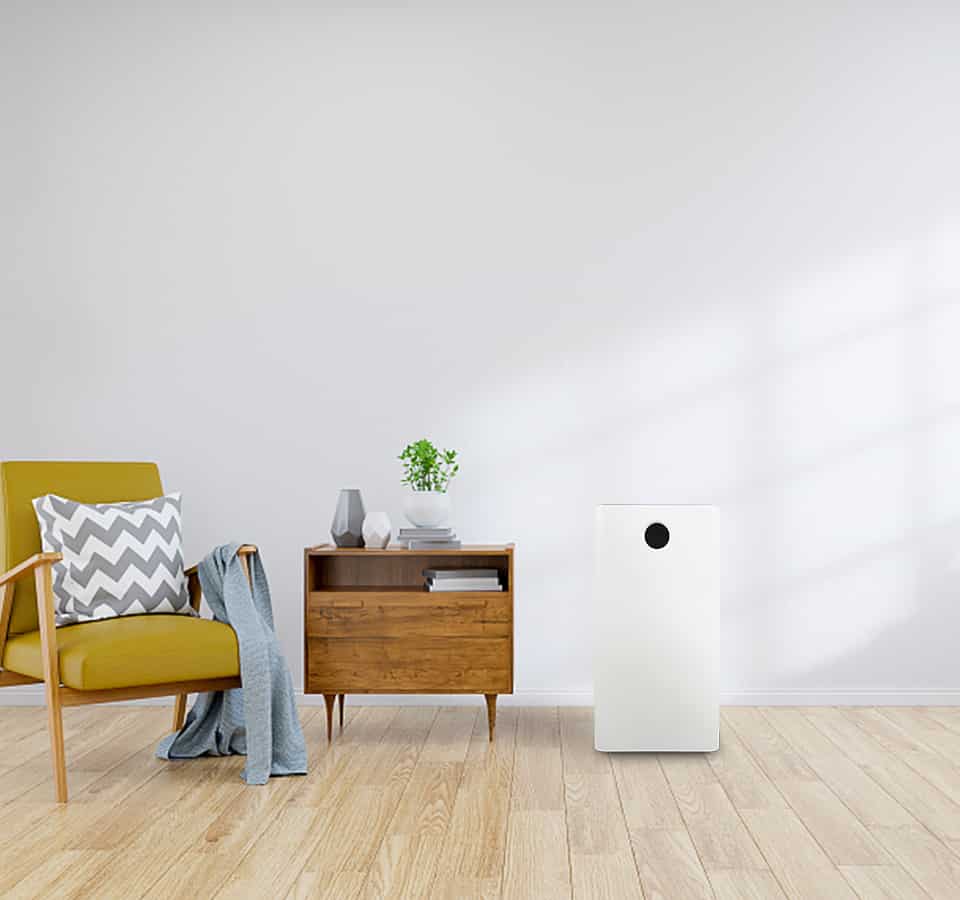
Explorar o mercado dos purificadores de ar assemelha-se a uma aventura emocionante com muito potencial. Esta viagem tem muitas possibilidades.
Iniciar uma marca de purificadores de ar nos EUA requer um investimento entre $50.000 e $100.000 para o primeiro ano. Este montante cobre o desenvolvimento do produto e o inventário. Inclui também os esforços de marketing e de vendas B2B.
Estes números podem confundir-vos no início. Lembro-me dessa sensação quando comecei a HisoAir. Compreender estes custos pode ensinar-lhe muito. Gastar dinheiro no desenvolvimento de produtos ajuda os seus purificadores de ar a serem únicos. A gestão do inventário e das existências ajuda o seu negócio a funcionar sem problemas. O marketing actua como o seu altifalante, especialmente em sites como o Amazon e o Shopify, pelo que o dinheiro para anúncios é crucial. As despesas com feiras comerciais e viagens são importantes se olharmos para as vendas B2B. Há muito para gerir. No entanto, com um planeamento cuidadoso e um pouco de coragem, começar a sua marca de purificadores de ar é muito gratificante.
O lançamento de uma marca de purificadores de ar requer 50K-100K USD no Ano 1.Verdadeiro
O contexto especifica este intervalo como o investimento inicial necessário.
A HisoAir utiliza a tecnologia Decibel Cancellation™ nos seus purificadores.Verdadeiro
O HisoAir integra esta tecnologia para um desempenho ótimo.
Quais são os principais custos envolvidos no desenvolvimento de produtos?
Alguma vez se perguntou onde é que o seu dinheiro desaparece quando cria um produto?
As despesas de desenvolvimento de produtos abrangem a investigação e o desenvolvimento, a conceção, a criação de protótipos, os ensaios, o fabrico, o marketing e a entrega. Um orçamento bem distribuído por estas etapas é crucial para um lançamento bem sucedido. É fundamental gastar bem.
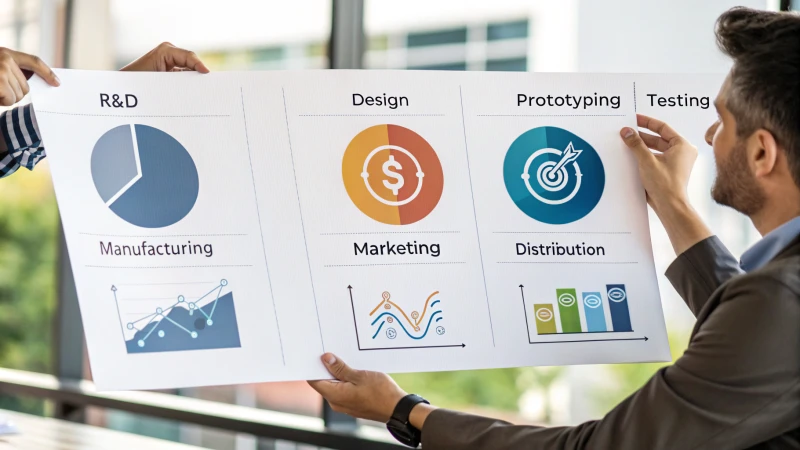
Custos de investigação e desenvolvimento (I&D)
A I&D é onde começa o meu percurso, estabelecendo as bases com caraterísticas especiais. É como desenhar um plano para o sucesso. Os estudos de mercado pareciam um trabalho de detetive para mim, tentando descobrir o que as pessoas realmente precisam e como eu poderia oferecer algo único. Os estudos de viabilidade funcionaram como controlos, garantindo que o meu sonho era realista.
| Actividades de I&D | Gama de custos estimados |
|---|---|
| Pesquisa de mercado | $5,000 - $20,000 |
| Estudos de viabilidade | $10,000 - $30,000 |
Custos de conceção e prototipagem
A fase de conceção é quando as ideias se tornam visíveis e reais. Achei esta parte excitante mas difícil. Contratação serviços de conceção profissional1 transforma uma simples ideia num produto pronto a ser comercializado. A prototipagem é como dar vida aos seus projectos, vital antes do início da produção em grande escala.
| Actividades de conceção | Gama de custos estimados |
|---|---|
| Design industrial | $5,000 - $25,000 |
| Prototipagem | $10,000 - $50,000 |
Custos de teste e certificação
Os testes mostram que o seu produto corresponde às expectativas. Esta fase é muito importante - é como fazer um exame final à sua criação. Por vezes, obter certificações é como ganhar distintivos que provam que o seu trabalho árduo valeu a pena.
| Actividades de teste | Gama de custos estimados |
|---|---|
| Testes funcionais | $5,000 - $15,000 |
| Certificação de segurança | $5,000 - $20,000 |
Custos de fabrico
O fabrico transforma a sua visão em algo real. Vi o meu sonho tornar-se realidade aqui. A gestão sensata dos materiais e da mão de obra afecta realmente os custos. Parceiros fiáveis decidem o sucesso do seu cronograma e orçamento.
| Actividades de fabrico | Gama de custos estimados |
|---|---|
| Ferramentas | $10,000 - $40,000 |
Custos de marketing e distribuição
O marketing liga o seu produto ao seu público. Criar uma estratégia de marketing pela primeira vez foi como planear uma grande revelação. Uma boa publicidade pode mudar o sucesso de um extremo para o outro.
| Actividades de marketing | Gama de custos estimados |
|---|---|
| Publicidade digital | $2,000 - $10,000 |
Equilibrar a qualidade e o custo ao longo destas fases é uma arte que aprendi a respeitar. Conhecer estas despesas manteve-me no caminho certo e pronto para um lançamento de produto bem sucedido.
O lançamento de uma marca de purificadores de ar nos EUA custa entre 50 mil e 100 mil dólares.Verdadeiro
O investimento inicial inclui a compra de acções, o desenvolvimento do produto e o marketing.
A HisoAir utiliza a tecnologia Decibel Cancellation™ nos seus purificadores de ar.Verdadeiro
O HisoAir integra funcionalidades avançadas como Decibel Cancellation™ para um desempenho ótimo.
Quanto deve ser orçamentado para o inventário e as existências?
Por vezes, olha para uma folha de cálculo, tentando perceber qual a quantidade de inventário necessária? Os empresários sabem que este é um ato de equilíbrio.
Planeio o meu orçamento para o inventário com base no tipo de produto e na concorrência existente no mercado. As condições dos fornecedores também são muito importantes. As previsões de vendas também ajudam neste processo. Normalmente, 25-40% do meu orçamento total vai para as existências. Isto é muito importante. É uma percentagem significativa do orçamento.

Compreender o tipo de produto e as necessidades do mercado
No negócio da purificação do ar, aprendi rapidamente que o tipo de produto que vendia afectava profundamente as minhas escolhas orçamentais. Imagine lançar um pequeno purificador de ar num mercado que já está cheio. Destacar-se exige mais do que um design sofisticado. As caraterísticas únicas exigem que se gaste mais no produto desenvolvimento2. O orçamento para o stock inicial era crucial, porque podia fazer a marca crescer ou desaparecer. Era realmente importante.
Condições do fornecedor e investimento inicial
Encontrar um bom fornecedor é como encontrar ouro. Desde cedo, apercebi-me de que era necessário obter boas condições. As quantidades mínimas de encomenda (MOQ) decidiam quanto eu investia em inventário. Por exemplo, 500 unidades a $60 cada significam $30.000 à cabeça, mesmo antes dos custos de transporte e dos direitos aduaneiros. É um montante elevado. No entanto, planear estas despesas provavelmente evita problemas mais tarde.
Previsões de vendas e rotação de stocks
As previsões de vendas funcionavam como a minha bola de cristal. Ajudavam-me a evitar stocks a mais ou a menos. Ao calcular o rácio de rotação das existências (custo das mercadorias vendidas dividido pelas existências médias), avaliei a minha gestão das existências.
| Rácio de rotação de inventário | Interpretação |
|---|---|
| Abaixo de 2 | Risco de excesso de stock |
| 2 a 4 | Rotatividade saudável |
| Acima de 4 | Carências potenciais |
Esta análise permitiu-me ajustar o meu orçamento de modo a ter produtos suficientes para satisfazer a procura sem ter de investir demasiado dinheiro. Era essencial.
Custos de marketing que afectam o orçamento de inventário
O marketing era outra parte importante. Plataformas como a Amazon tornaram-se as minhas preferidas, com anúncios que custavam $4-$5 por clique. Com uma taxa de conversão de 10%, rapidamente percebi a necessidade de orçamentar $100-$200 diariamente para manter o tráfego a fluir. Estes custos de marketing afectaram diretamente o meu inventário3 necessidades, uma vez que vender mais significava ter produtos suficientes prontos.
A orçamentação do inventário não se resumia apenas a números; envolvia a compreensão do impacto de cada peça no meu trabalho. Ao considerar tudo, desde o tipo de produto até aos planos de marketing, foram reservados fundos para manter as operações sem sobrecarga.
Tirar partido da tecnologia para a elaboração do orçamento
A introdução de software de orçamentação na minha rotina mudou tudo. Estas ferramentas permitiram o controlo de stocks em tempo real e alertas automáticos de encomendas. Mantiveram-me à frente no mercado competitivo.
Ao combinar estratégias com tecnologia, desenvolvi um plano orçamental sólido que apoiou o crescimento e a sustentabilidade ao longo do meu percurso empresarial.
O lançamento de uma marca de purificadores de ar requer $50K-$100K no Ano 1.Verdadeiro
O investimento inicial inclui a compra de acções, o desenvolvimento do produto e o marketing.
Os anúncios da Amazon custam $4-$5 por clique com uma taxa de conversão de 10%.Verdadeiro
Este é o custo médio e a taxa de conversão da publicidade na Amazon.
Quais são as despesas de marketing para vender na Amazon e no Shopify?
Navegar pelo labirinto das despesas de marketing na Amazon e na Shopify é um pouco como montar um puzzle.
Ao vender na Amazon, prepare-se para atribuir fundos para PPC anúncios com preços à volta de $4-5 por clique. O Shopify necessita de investimento em anúncios nas redes sociais e SEO em vez disso. Ambas as plataformas requerem uma orçamentação cuidadosa. Isto é crucial para alcançar o sucesso. A orçamentação é essencial.
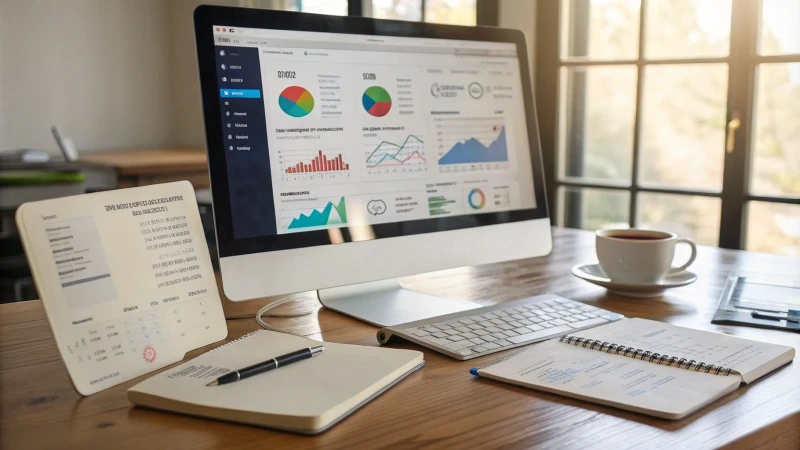
Explorar os custos de publicidade da Amazon
Vender na Amazon introduziu um novo mundo de PPC (pay-per-click). Cada clique custa cerca de $4-5 e, com uma probabilidade de venda de apenas 10%, apercebi-me de que precisava de $100-200 por dia só para os anúncios. Outros custos incluem as taxas de referência da Amazon e o Fulfillment by Amazon (FBA), que variam consoante a categoria e o tamanho do produto. Calculei cuidadosamente todas as taxas para não me limitar a atingir o ponto de equilíbrio e obter um lucro efetivo. Cada taxa era importante porque o lucro era essencial.
Abordagem de marketing da Shopify
Mudar para a Shopify foi como descobrir novas oportunidades. A plataforma permite liberdade nas estratégias de marketing. Concentrei-me em anúncios nas redes sociais4A campanha de marketing da empresa, que utiliza o Instagram e o Facebook para atrair visitantes. Este método pareceu-me mais pessoal e menos assustador em termos de custos, com campanhas iniciais de cerca de $2000. Prestar atenção à otimização dos motores de busca (SEO) foi muito importante para o alcance natural. Ao contrário da Amazon, a Shopify não tem taxas de listagem, mas os temas, as aplicações e as taxas de cartão de crédito aumentam.
Comparação de despesas de marketing: Amazon vs. Shopify
| Tipo de despesas | Amazon | Shopify |
|---|---|---|
| Publicidade | PPC ($4-5/clique) | Redes sociais e SEO (variado) |
| Taxas de plataforma | Referência & FBA taxas | Taxas de subscrição e de transação |
| Custos adicionais | Taxas de inscrição | Aplicações e temas |
Compreender estas diferenças ajudou-me a afetar os orçamentos de forma sensata e a escolher a plataforma certa com base na minha objectivos comerciais5. Por vezes, a utilização de ambas as plataformas é provavelmente a melhor opção.
Orçamentação estratégica para o sucesso do comércio eletrónico
Para obter os melhores resultados, aprendi a planear bem as despesas de marketing em ambas as plataformas. Analisei sempre aspectos como as taxas de conversão e o retorno do investimento em publicidade (ROAS). Experimentar diferentes tipos de anúncios e ajustar os orçamentos com base nos resultados conduziu a um maior sucesso. Conselhos de especialistas em comércio eletrónico6 ajudou a melhorar as minhas estratégias e a obter conhecimentos para um crescimento contínuo neste mercado competitivo. O conhecimento das mudanças na plataforma manteve as minhas tácticas de marketing eficazes e actualizadas.
O lançamento de uma marca de purificadores de ar requer $50K-$100K no Ano 1.Verdadeiro
Isto é verdade porque o investimento inicial inclui custos de stock, desenvolvimento de produtos e marketing.
Os anúncios da Amazon custam $4-$5 por clique com uma taxa de conversão de 10%.Verdadeiro
O custo médio por clique na Amazon é de $4-$5 com uma taxa de conversão de 10%.
As feiras comerciais são um investimento inteligente para as vendas B2B?
Pergunta-se muitas vezes se essas feiras comerciais concorridas valem o custo elevado do seu plano de vendas B2B?
Sim, participar em feiras comerciais é um ótimo investimento para as vendas B2B. Estes eventos oferecem grandes hipóteses de encontrar novos clientes. Também ajudam a mostrar a sua marca a muitas pessoas. Também é possível estabelecer contactos com outras pessoas do sector. É importante verificar os custos e a adequação do evento à sua estratégia.

Avaliação de custos e benefícios
Quando comecei a pensar em ir a feiras comerciais, os custos elevados surpreenderam-me. As despesas, como os custos dos stands e as deslocações, eram elevadas, mais de $50.000. Pareceu-me avassalador. No entanto, o potencial7 O retorno do investimento (ROI) através de novos contactos pode trazer bons resultados. De repente, tudo parecia mais claro.
Oportunidades de trabalho em rede
As feiras de negócios são como uma festa gigante para as empresas. Senti-me simultaneamente nervoso e entusiasmado na minha primeira feira. Conhecer outras pessoas do sector não era apenas uma questão de encontrar clientes; era também uma questão de criar ligações que poderiam levar a futuros projectos e parcerias. O valor de aumentar a minha rede profissional era enorme.
| Benefícios | Detalhes |
|---|---|
| Geração de leads | Acesso a um vasto leque de potenciais clientes |
| Visibilidade da marca | Oportunidade de apresentar produtos e serviços |
| Pesquisa de mercado | Informações sobre as tendências do sector e os concorrentes |
Considerações estratégicas
Nem todas as feiras comerciais são iguais. Escolher as que correspondem aos meus objectivos tem-se revelado importante. Escolho eventos onde o meu público ideal estará presente. Esta estratégia altera bastante os resultados, uma vez que se trata de escolher realmente o direito8 apto.
Utilizar a tecnologia
A adição de ferramentas digitais mudou tudo para mim. Incorporar elementos como stands virtuais e palestras transmitidas ao vivo ajudou-me a chegar a mais pessoas do que antes, levando efetivamente o evento àqueles que não estavam presentes pessoalmente.
Para qualquer empresa B2B que esteja a pensar em feiras comerciais, um planeamento muito detalhado é provavelmente muito importante. A comparação de possíveis benefícios e custos, a experimentação de novas ideias e a utilização de espaços reais e digitais podem melhorar a eficácia de um evento. A minha experiência mostra que, com um plano inteligente, as feiras comerciais tornam-se mais do que apenas gastar dinheiro; são verdadeiramente um investimento no crescimento futuro.
O lançamento de uma marca de purificadores de ar nos EUA custa $50K-$100K.Verdadeiro
O contexto apresenta um intervalo de investimento estimado para o lançamento da marca.
Os anúncios da Amazon custam $4-5 por clique com uma taxa de conversão de 10%.Verdadeiro
O contexto especifica estes custos médios e taxas de conversão para os anúncios da Amazon.
Conclusão
O lançamento de uma marca de purificadores de ar nos EUA exige um investimento de $50.000 a $100.000 para o desenvolvimento do produto, inventário e esforços de marketing no primeiro ano.
-
Saiba como os serviços de design profissional melhoram o atrativo e a funcionalidade dos produtos. ↩
-
Explorar a forma como o investimento em caraterísticas únicas dos produtos aumenta a competitividade e justifica a afetação do orçamento. ↩
-
Descubra como estratégias de marketing eficazes podem otimizar os níveis de inventário e melhorar o desempenho das vendas. ↩
-
Explore estratégias eficazes para usar anúncios em redes sociais para direcionar tráfego para sua loja da Shopify. ↩
-
Aprenda métodos para identificar o seu mercado-alvo, crucial para alinhar os esforços de marketing com as necessidades do público. ↩
-
Compreenda como os especialistas em consultoria podem melhorar as suas estratégias de comércio eletrónico e melhorar o ROI. ↩
-
Ao clicar nesta hiperligação, pode ficar a saber como é que as feiras comerciais podem aumentar significativamente a geração de contactos, um aspeto essencial das vendas B2B. ↩
-
Esta hiperligação oferece orientações sobre a escolha de feiras comerciais que estejam de acordo com os objectivos da empresa, optimizando o seu investimento. ↩


